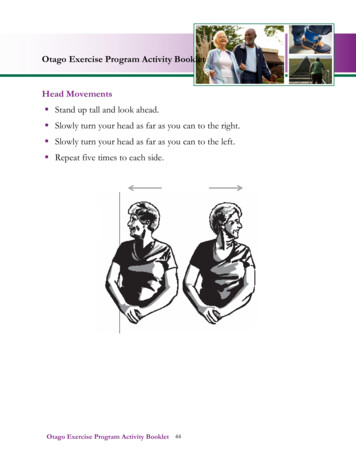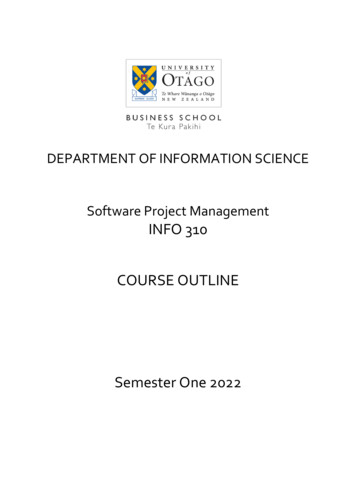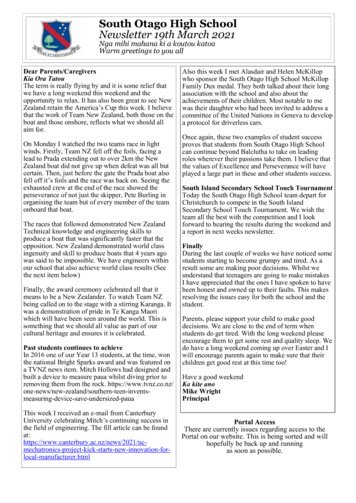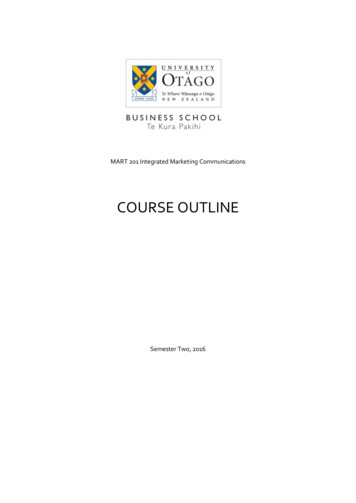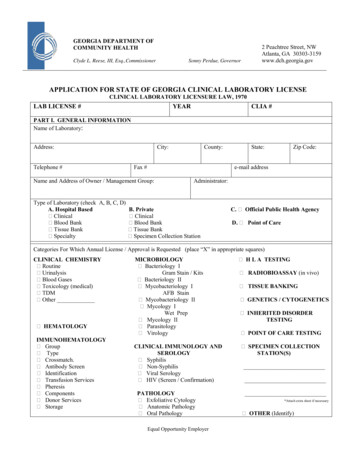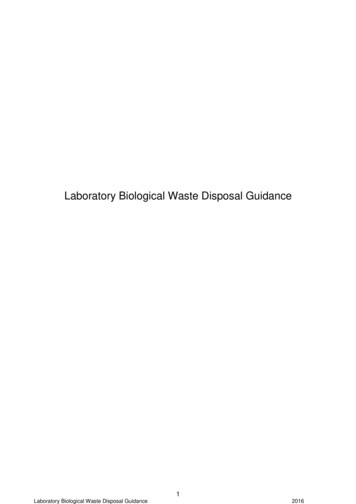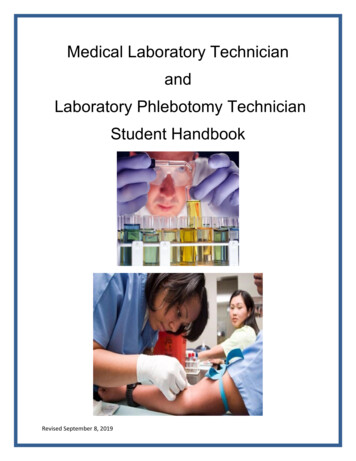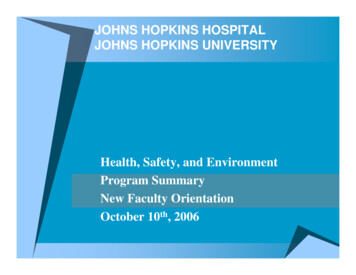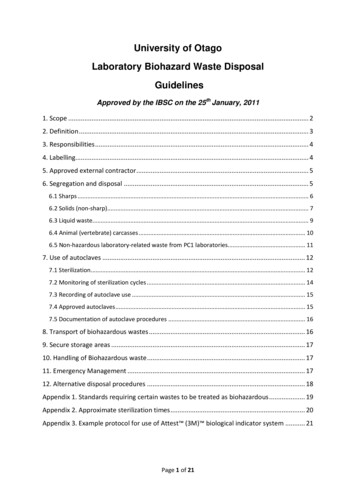
Transcription
University of OtagoLaboratory Biohazard Waste DisposalGuidelinesApproved by the IBSC on the 25th January, 20111. Scope . 22. Definition . 33. Responsibilities . 44. Labelling. 45. Approved external contractor . 56. Segregation and disposal . 56.1 Sharps . 66.2 Solids (non-sharp). 76.3 Liquid waste. 96.4 Animal (vertebrate) carcasses . 106.5 Non-hazardous laboratory-related waste from PC1 laboratories. 117. Use of autoclaves . 127.1 Sterilization. 127.2 Monitoring of sterilization cycles . 147.3 Recording of autoclave use . 157.4 Approved autoclaves . 157.5 Documentation of autoclave procedures . 168. Transport of biohazardous wastes . 169. Secure storage areas . 1710. Handling of Biohazardous waste . 1711. Emergency Management . 1712. Alternative disposal procedures . 18Appendix 1. Standards requiring certain wastes to be treated as biohazardous . 19Appendix 2. Approximate sterilization times . 20Appendix 3. Example protocol for use of Attest (3M) biological indicator system . 21Page 1 of 21
1. ScopeThese guidelines are intended to cover biohazardous wastes originating in laboratory areas atthe University of Otago, including (but not restricted to) those laboratories that are registeredas part of the University of Otago Containment and Transitional Facility for Microorganismsand Uncleared Biological Products.Biohazardous wastes originating from such areas must be decontaminated in accordance withthe requirements of the following standard;AS/NZS2243.3:2002 (Safety in laboratories, Part 3: Microbiological aspects andcontainment facilities).The purpose of these guidelines is to provide guidance on managing the treatment and/ordisposal of biohazardous wastes in a manner that is safe and complies with the requirementsof the above standard, but these guidelines DO NOT COVER the disposal of the following;i) Human cadavers or body parts.ii) Biological wastes that are not biohazardous and which are not specifically required tobe treated as such by any New Zealand legislation, Standard or project approval.iii)Any wastes originating from specific facilities or projects which are subject to disposalrequirements other than those specified in AS/NZS2243.3:2002 (for example, disposalrequirements specified in an Import Health Standard or as containment controls in anERMA/IBSC project approval). 11The Sector Manager responsible for such facilities or projects must ensure disposal procedures meet therequirements of any applicable standards or project approval controls.Page 2 of 21
2. DefinitionA biohazard is any material that may contain an infectious agent or other hazardous biologicalmaterial that presents a potential risk to the health of humans, animals or the environment 2.In practice, this means that all of the following wastes must be treated as biohazardous;i)Any waste that may be contaminated with pathogenic microorganisms, including;human blood and body fluids, cultures of pathogenic microorganisms and carcassesof infected laboratory animals.ii) Any waste contaminated with organisms or biological materials that have not beenapproved for release outside of a Containment or Transitional Facility (including theUniversity of Otago Containment and Transitional Facility for Microorganisms andUncleared Biological Products), including; any genetically modified organisms,imported uncleared biologicals, animal cell cultures, unwanted organisms, carcassesof laboratory animals infected with genetically modified organisms or which containgenetically modified cells or tissue (e.g. as a graft or implant) and any other ‘riskgoods’.iii) Any obviously laboratory-related waste that originates from a PC2 laboratory,particularly disposable lab-ware such as used gloves, pipette tips, petri dishes, plasticsyringes and tubes, irrespective of whether the waste is known to be contaminated ornot (unless the waste is known to be non-biohazardous, but is contaminated with ahazardous substance or radioactive material and is subject to other specific disposalrequirements for these hazardous wastes) 3. Note that there are specific requirementsfor the disposal of non-hazardous laboratory-related waste from PC1 laboratories andthese are detailed in Section 6.5.2Note that certain wastes are specifically required to be treated as biohazardous under various New Zealandstandards. Examples that commonly occur at the University of Otago are listed in Appendix 1.3Note that this requirement is to minimise the risk of any material contaminated with a biohazard from a PC2laboratory being accidentally disposed into the general waste stream. In addition, cleaners are trained not totouch or empty waste bins that contain obviously laboratory-related material (this is again to minimise the risk ofcontaminated waste being accidentally disposed of into the general waste stream, as well as to protect the healthand safety of cleaning personnel).Page 3 of 21
3. ResponsibilitiesDepartments which generate biohazardous wastes MUST have disposal procedures in placewhich meet the requirements of these guidelines and anyone working with biohazardousmaterial must receive training in these procedures. Anyone generating a biohazardous wasteis responsible for disposing of this in accordance with the procedures that apply in their area.Responsibility for ensuring appropriate procedures are in place lies with either the SectorManager, for wastes originating from laboratories that are part of a MAF-auditedContainment or Transitional Facility, or with the Departmental Laboratory Manager (DLM),for wastes originating from PC2 Clinical Laboratories where human blood and body fluids arehandled.4. LabellingAll containers of biohazardous waste (including bins used to contain biohazard bags) MUSTbe clearly labelled with a Biohazard warning symbol (Figure 1, page 5). Note that (A) is thebiohazard warning symbol specified for internal facility use in both AS/NZ2243.3:2002 andNZS4304:2002, while (B) is a MAF approved warning symbol (and is required to be used ondoor signs of PC1 and PC2 laboratories). Either (A) or (B) may be used for labelling fridges,freezers, bins and other containers or areas that contain biohazardous materials.Symbol (C) is the official UN Transport of Dangerous Goods pictogram for InfectiousSubstances (Class 6.2) but in general this should not be used for internal facility use, with theexception of items that are specifically designed for the transport of biohazardous materials(including biohazard bags and bins).Figure 1. Biohazard symbols(B)(A)(C)Page 4 of 21
5. Approved external contractorSome biohazard waste disposal procedures require waste to be removed for decontaminationby an ‘approved external contractor’. Currently, the approved external contractor for allbiohazardous wastes is Interwaste Ltd. For any queries relating to the services provided byInterwaste Ltd (including pricing) please contact the Custodial Services Manager at PropertyServices.6. Segregation and disposalThe appropriate disposal procedure for biohazardous waste depends on the type of waste andas a result all biohazardous waste must be segregated into one of the following types;i)Sharps, e.g. contaminated needles, scalpel blades, microscope slides, blood tubes. Refer SECTION 6.1ii) Solid, e.g. contaminated gloves, paper towels, agar, plasticware. Refer SECTION 6.2iii) Liquid, e.g. cultures, trap waste, used media. Refer SECTION 6.3iv) Animal (vertebrate) carcasses Refer SECTION 6.4v) Non-hazardous laboratory-related waste from PC1 laboratories Refer SECTION 6.5vi) All other biohazardous wastes Refer SECTION 12Wastes that contain hazardous substances (i.e. substances with a HSNO classification) or arecontaminated with radioactive materials MUST NOT be disposed of with biohazardouswaste, except where this is specifically permitted in any relevant guidelines for the hazardoussubstance/radioactive material involved.All practical steps should be taken to avoid mixing biohazardous waste with other hazardouswastes (e.g. toxic, radioactive). Where the generation of mixed wastes is unavoidable theBiological Compliance Officer MUST be consulted to determine the appropriate disposalmethod BEFORE the waste is generated.Page 5 of 21
6.1 SharpsBiohazardous sharps waste includes any of the following;i)Any potentially biohazardous items that could break or puncture the skin, e.g.needles, scalpel blades, glassware 4.ii) Any potentially biohazardous items that could break or puncture a biohazard bag e.g.large items of rigid plasticware.All biohazardous sharps must be decontaminated off-site by the approved external contractor.Sharps waste must be discarded directly into approved sharps containers (labelled with boththe biohazard symbol and the word ‘Sharps’). These can be obtained from the approvedexternal contractor and come in a variety of sizes. Sharps containers are also available with‘flip-top’ lids (see Figure 2, page 7) or plain lids. Flip-top lids are recommended where binsare used for disposal of small sharps such as needles and scalpels, but plain lids may be morepractical for larger items e.g. plastic pipettes, glassware.Biohazard sharps containers should be filled no higher than 2/3 full or to the indicator line onthe outside of the bucket, if one is present (see Figure 3, page 7). The container should thenbe sealed and labelled with the department/area the waste originates from (for laboratorywaste, also label with the lab group/room number). Store containers in a secure area (referSection 9) until collection by the approved external contractor.Sharps MUST NEVER be placed into biohazard bags as they may puncture the bag,potentially resulting in spillage of biohazardous material and/or injury.DO NOT attempt to empty the contents of one biohazard sharps bucket into another.On-site decontamination of sharps waste IS NOT permitted.4Including intact glassware, as this can easily break and create a sharps hazard.Page 6 of 21
Figure 2 – Sharps container with ‘flip-top’ lidFigure 3 – Correct and incorrect filling of biohazard sharps containers Good - Bucket shouldbe filled no higherthan this indicator line(red arrow). Bad – contents are overflowingfrom the bucket and the lid cannotbe closed.6.2 Solids (non-sharp)Biohazardous solid waste typically consists of items such as contaminated gloves, papertowels, plasticware and agar. Small volumes of liquid waste may also be included providedthat any liquids are sealed in plastic tubes (e.g. microfuge tubes, falcons) of no greater than 50mL volume and that the total aggregate volume per biohazard bag/bin does not exceed 500mL.Biohazardous solid waste may be disposed of either by decontamination off-site by theapproved external contractor or on-site by autoclave sterilisation.Page 7 of 21
6.2.1 Biohazard bags (off-site decontamination)Where this method of disposal is used, solid waste MUST be placed into a yellow biohazardbag that is lined with a paper kleensac (this helps prevent puncturing or tearing of the plasticbag) 5. When in use (i.e. the bag is open) the biohazard bag and liner should be containedwithin a solid-sided bin with a lid (these bins may also be used to transport waste throughnon-laboratory areas). Biohazard bags must be filled no higher than 2/3 full (see Figure 4,below), sealed with a cable tie or tape, then labelled with the department/area the wasteoriginates from (for laboratory waste, also label with the lab group/room number). Storebiohazard bags in a secure area (refer Section 9) until collection by the approved externalcontractor.Figure 4 – Correct and incorrect filling of biohazard bags Good – Bag 2/3 full Bad - Bag is over full6.2.2 Biohazard bags (on-site decontamination)Only specifically approved autoclaves (designated by the Sector Manager or DLM) may beused for decontamination of solid biohazard waste and this option may not be provided in allareas. Where this method of disposal is used, solid waste must be disposed of in eitherautoclave bags or yellow biohazard bags. Users should take care not to place intact biohazardwarning labels into these bags as these will enter the general waste stream intact (unlikecommercially treated bags, which are shredded following sterilisation).Autoclave/Biohazard bags: Follow the guidelines for disposal of waste into Biohazard bagsas detailed in section 6.2.1, with the exception that the bags should be sealed with clips and5Solid waste may also be disposed into biohazard sharps containers, in accordance with Section 6.1, althoughthis is a more expensive disposal option.Page 8 of 21
these should be removed just prior to autoclaving. Autoclave sterilization MUST be carriedout in an approved autoclave in accordance with the guidelines in Section 7. Followingautoclaving, check that no biohazard labels on the exterior of the bag remain legible. If anylabels remain these must be defaced prior to disposal (they will usually be destroyed duringthe autoclave process). The bags may then be disposed of into the general waste stream (e.g.rubbish skip).6.3 Liquid wasteLiquid waste should be further segregated into either “high organic load” (as a guideline, 105cells/mL) , e.g. microorganism/cell cultures, blood and body fluids, or “low organic loadwaste” (as a guideline, 105 cells/mL), e.g. trap wastes, used media, culture supernatants.Note that any liquid waste that may contain spores MUST be treated as a high organic loadwaste.High organic load liquid wastes MUST be decontaminated off-site by an approved externalcontractor or on-site by autoclave sterilization in an approved autoclave.Low organic load wastes may be decontaminated in the same manner as high organic loadwastes or treated on-site by chemical disinfection.6.3.1 High organic load waste (off-site decontamination)Small volumes of high organic load waste that are sealed in plastic tubes ( 50 mL per tubeand 500 mL aggregate volume) may be placed with solid waste into biohazard bags (refersection 6.2.1) or biohazard sharps containers (refer section 6.1). However, high organic loadliquid wastes MUST NOT be poured directly into biohazard sharps containers.Larger volumes ( 50 mL per tube or 500 mL total) MUST be disposed of on-site byautoclave sterilisation in an approved autoclave (see 6.3.2).6.3.2 High organic load waste (on-site decontamination)Only specifically approved autoclaves (designated by the Sector Manager or DLM) may beused for decontamination of liquid biohazard waste. Liquid waste must be placed in anautoclavable container (if it is not already in an appropriate container) and the lid loosened (orvented closure used). Autoclave sterilization MUST be carried out in an approved autoclavein accordance with the guidelines in Section 7. The decontaminated waste may then bedisposed down a laboratory sink.6.3.3 Low organic load wasteLow organic load wastes may be decontaminated as for high organic load wastes (i.e. as perSections 6.3.1 or 6.3.2) OR by chemical disinfection. Guidelines for chemical disinfectionusing chlorine bleach (sodium hypochlorite) and Virkon are given below (these are examplesonly, actual protocols may vary depending on the waste and the protocol followed should bePage 9 of 21
documented). DO NOT chemically disinfect materials that will be autoclaved – as this maydamage sterilising equipment and expose users to hazardous fumes (especially if sodiumhypochlorite is used).Chlorine bleach disinfection: Chlorine bleach is typically supplied as 5% sodiumhypochlorite. To disinfect low organic load wastes, add chlorine bleach to give a finalconcentration of 0.25% (i.e. add 50 mL of 5% sodium hypochlorite per 1 L of waste). Mixand leave to stand for a minimum of 1 hour. The treated waste may then be disposed of downa laboratory sink.Virkon disinfection: Virkon is commercially available disinfectant with proven effectivenessacross a broad range of fungi, bacteria and viruses and is supplied as powder or tablets(Virkon solutions should be prepared fresh). To disinfect low organic load wastes, dissolveVirkon in waste to a concentration of 1% (e.g. by adding 10 g/L waste), then leave to standfor a minimum of 1 hour. The treated waste may then be disposed of down the laboratorysink.6.4 Animal (vertebrate) carcassesCarcasses of vertebrate laboratory animals that are genetically modified, which containgenetically modified cells or tissue (e.g. as a graft or implant), or which are infected withgenetically modified microorganisms or pathogenic microorgansims must be treated asbiohazardous. Typically, these carcasses will originate from animals that were held in aVertebrate Laboratory Animal Containment Facility (i.e. PC2 Animal area) when they werealive, but which may have been removed from these areas for experimental purposes.All biohazardous animal carcasses MUST be disposed of as ‘Animal waste’ through anapproved external contractor and are not permitted to be decontaminated on-site 6. Suchcarcasses must be sealed in a plastic bag and transferred to either a biohazard bin or bag thatis designated specifically for this purpose (i.e. animal carcasses MUST NOT be discardedinto biohazard bags used for other solid biohazardous laboratory waste). This bin or bagmust be kept in a secure area (refer section 9) with appropriate temperature control (e.g.fridge, freezer, cold room) until it can be collected by the approved external contractor. Thedeath and disposal of any animal carcasses from a Vertebrate Laboratory AnimalContainment Facility must be recorded in the appropriate register.PC2 Animal areas must have appropriate disposal procedures in place for the disposal of allbiohazardous animal carcasses. However, where animals have been removed from a PC2Animal area for experimental purposes it is the responsibility of the animal user to ensureappropriate disposal procedures are in place in their area of work, or to dispose of anycarcasses through the facility from which the animal originated.6Except where other disposal procedures are specified in a project approval or import health standard – in whichcase these must be followed.Page 10 of 21
Note that bedding that originates from cages used to house animals infected with pathogenicmicroorganisms MUST also be treated as biohazardous and may either be decontaminatedon-site (by autoclave sterilization) or off-site (by collection and disposal through the approvedexternal contractor) as per the requirements for decontamination of solid waste outlined inSection 6.2. Animal bedding from cages of non-infected animals is not required to be treatedas biohazardous and can be disposed of through the general waste stream.6.5 Non-hazardous laboratory-related waste from PC1 laboratoriesPC1 laboratory waste which is obviously laboratory-related in nature, particularly disposablelab-ware such as used gloves, pipette tips, petri dishes and tubes, but which is known to benon-hazardous (i.e. is not contaminated with any known biohazard, hazardous substance orradioactive material), MUST NOT be disposed of into general waste bins emptied byUniversity cleaners. Such waste must be disposed of by one of the following two methods;i.The waste may be treated as biohazardous and disposed of in accordance withsections 6.1 and 6.2.ii.The waste may be collected in waste bins that are clearly labelled to the effectthat they are not to be emptied by cleaners . This waste must be double-baggedand disposed of into a waste skip (or other appropriate receptacle approved forthis purpose by the Biological Compliance Officer) by laboratory personnel.Note that University cleaners are trained not to touch or empty waste bins that containobviously laboratory-related material. This is to minimise the risk of contaminated wastebeing accidentally disposed of into the general waste stream and to protect the health andsafety of cleaning personnel.Page 11 of 21
7. Use of autoclavesOn-site decontamination by autoclave sterilization may only be used for those wastes wherethis is specifically indicated as a disposal option in the preceding sections (6.1-6.4) and inareas where suitable approved autoclaves are available (refer section 7.7).Autoclave sterilization should be available in all areas which generate high organic loadliquid wastes (Section 6.3), but is not required to be provided for solid waste disposal (Section6.2.2) where procedures are in place for collection and disposal of solid wastes by anapproved external contractor (Section 6.2.1).When autoclaves are to be used for on-site decontamination of biohazardous wastes it isimperative that there are standard operating procedures in place to ensure that these wastes aretreated in a manner that renders them safe for disposal into the general waste stream (and inaccordance with the requirements of AS/NZS2243.3:2002 and NZS4304:2002).There are a wide range of different makes, models and ages of autoclave in use across thecampus and it is not possible to provide detailed instructions for the correct use of each ofthese. However, this section provides general guidelines that should be followed 7.7.1 SterilizationThe correct use of autoclaves to decontaminate biohazardous wastes requires a goodunderstanding of the appropriate autoclave type and sterilizing conditions to use for differenttypes and volumes of waste.7.1.1 Autoclave typeThere are three main autoclave types that are commonly used and each is suited to differentwaste types;Pressure cookers: These rely on heating water within the sterilizer to generate steamand pressure. In general, these provide poor control of sterilizing conditions and MUSTNOT be used for the decontamination of biohazardous wastes without the writtenapproval of the Biological Compliance Officer (they may be approved for certain wastes,e.g. low organic load liquids, with appropriate validation).Downward displacement (Gravity) Sterilizers: Steam of the desired temperature isgenerated separately and is admitted into the autoclave chamber, relying on gravity todisplace ambient air. Porous materials and large containers (e.g. buckets, biohazard bags)that do not allow the downward escape of air may trap pockets of air and preventpenetration of steam into the load, leading to incomplete sterilization.7Detailed guidelines are also provided in AS/NZS2243.3:2002.Page 12 of 21
This type of sterilizer IS recommended for the decontamination of liquid wastes (Section6.3), but IS NOT recommended for treating large containers of solid waste such asbiohazard bags.Pre-vacuum (Porous load) sterilizers: These work in a similar manner to downwarddisplacement sterilizers except that they employ a pre-vacuum stage to remove anytrapped air from the load that might block the penetration of steam. This type of sterilizerIS recommended for decontaminating ‘porous loads’, including biohazard bags (Section6.2) or other large containers of solid biohazard waste.Some modern autoclaves are capable of running as both downward displacement and prevacuum (porous load) sterilizers, and for such autoclaves it is important that users understandwhat type of cycle is being run (and what cycle is appropriate for the waste type beingprocessed). Clear instructions should be present at the autoclave in such cases.7.1.2 Sterilization cycle conditionsAt a minimum, all parts of the load (i.e. waste) must reach either a temperature of 121 C for15 minutes or 134 C for 4 minutes (in order to achieve complete sterilization) 8. However, inorder to allow time for the load to equilibrate to the same temperature as the autoclave theMINIMUM sterilization times that MUST be used are 9;a) 121 C for 20 minutes; orb) 134 C for 10 minutesThese are minimum sterilization times only and may not be sufficient to achieve completesterilization of all load types and volumes. Approximate guidelines of the sterilization timesrequired for different volumes of waste at 121 C (using a downward displacement sterilizer)are given in Appendix 2.Any sterilizing conditions that are used for decontaminating biohazardous waste should bevalidated through the use of biological indicators (as described in Section 7.2.2).8As specified in AS/NZS2243.3:20029Sterilization times are taken from the point at which the autoclave reaches the desired temperature and DONOT include the time taken for the autoclave to warm up.Page 13 of 21
7.2 Monitoring of sterilization cyclesAutoclaves that are used to decontaminate biohazardous wastes MUST be regularlymonitored to ensure that target sterilization conditions are achieved and are effective 10.Monitoring shall be carried out by annual calibration and by regular testing with biologicalindicators.7.2.1 CalibrationAll autoclaves used for the purpose of decontaminating biohazardous waste MUST becalibrated annually11. An annual calibration service will be organised centrally through theHealth and Safety Compliance Office, with the costs met by the departments involved.Individual departments may also organize the calibration of their own autoclaves if theyprefer.7.2.2 Biological indicatorsBiological indicators (such as spore strips) MUST be used to monitor the sterilisation processat a minimum of once per month or whenever the autoclave is used (if autoclave is used lessthan once per month) 12. For high-use autoclaves (those that are typically used at least onceper day) monitoring should be carried out weekly.A number of biological indicators are commercially available and any of these may be usedproviding the ‘kill time’ of the indicator is equal to or greater than 15 minutes at 121 C, or 4minutes at 134 C (i.e. the indicator provides confirmation that the minimum sterilizationtimes specified in AS2243.3:2002 are achieved).Note that careful consideration should be given to the placement of the biological indicatorsto ensure these provide meaningful results i.e. biological indicators should be placed withinthe part of the load that is likely to take the longest time to reach the desired temperature. (orwithin a ‘test load’ that is representative of the largest load item that would be processed).10“Sterilisation and disposal procedures of biological waste must be scientifically validated and shown to beeffectively used in the facility to devitalise the waste being treated.” (from: MAF Biosecurity NZ/ERMA NZStandard Facilities for Microorganisms and Cell Cultures:2007a)11The annual certification that is organized by Property Services only checks that the instrument is safe tooperate and DOES NOT confirm that the desired sterilization conditions are actually achieved.12“Biological indicators, such as spore strips, should be used at regular intervals (e.g. monthly) to monitor themicrobial killing power of the sterilization process.” (from:AS/NZS2243.3:2002 – Safety in Laboratories Part 3:Microbiological aspects and containment facilities)Page 14 of 21
Examples of biological indicators that are available are;Attest Biological Indicator System for 121 C gravity or 132 C vacuum-assistedsteam cycles (3M , Cat No. 1262 or 1262P): Suitable for placement within or betweenitems of solid waste sterilized with 121 C gravity or 132 C vacuum assisted steam cycles(distributed by Biolab).MagnaAMP Self Contained Biological Indicator Ampoules for Monitoring SteamSterilization of Liquids. 105 or 106 Geobacillus stearothermophilus. (SGM Biotech Inc.,Cat No. MA/6): Suitable for placement into liquid loads sterilized at 121 C (distributed byAustmel Pty Ltd).An example protocol for the use of the Attest (3M ) biological indictor system is providedin Appendix 3. Any failure of
for the disposal of non-hazardous laboratory-related waste from PC1 laboratories and these are detailed in Section 6.5. 2 Note that certain wastes are specifically required to be treated as biohazardous under various New Zealand standards. Examples that commonly occur at the University of Otago are listed in Appendix 1.
